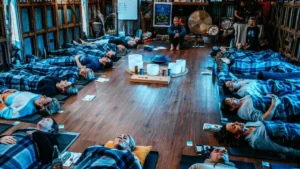Have you ever felt a quiet pull toward something deeper, something beyond the hustle of daily life? I remember my first brush with mysticism—it was during a rainy afternoon in London, where I stumbled into an Art of Living session out of sheer curiosity. What started as a quest for stress relief turned into a profound exploration of the self. In the United Kingdom, The Art of Living Foundation weaves mysticism into everyday practices, blending ancient wisdom with modern living. This article dives deep into how mysticism flourishes through their programs, offering tools for anyone seeking peace and purpose.
What is Mysticism?
Mysticism isn’t about cloaked figures chanting in dim rooms; it’s the pursuit of direct, personal experience with the divine or the infinite. At its core, it’s about transcending ordinary perception to touch a deeper reality, often through meditation or breathwork. In the context of The Art of Living, mysticism opens doors to self-awareness, where ancient scriptures meet scientific insights to reveal life’s hidden layers.
Historical Roots of Mysticism
Mysticism has danced through human history, from ancient shamans to medieval saints like Teresa of Avila. It’s the thread connecting diverse traditions, emphasizing union with the ultimate. Today, in the UK, it’s evolving, blending Eastern philosophies with Western curiosity for a fresh take on spiritual growth.
Mysticism in Modern Life
Gone are the days when mysticism was reserved for monks; now it’s accessible in urban settings like London or Manchester. People turn to it for relief from anxiety, finding that simple practices can spark profound insights. It’s like upgrading your mental software—suddenly, life’s glitches feel manageable.
The Art of Living Foundation: An Overview
Founded by Sri Sri Ravi Shankar in 1981, The Art of Living is a global nonprofit dedicated to stress reduction and spiritual empowerment. In the UK, it offers workshops that integrate yoga, meditation, and breath techniques. It’s not a religion but a path to inner peace, helping thousands navigate modern chaos with ancient tools.
Sri Sri Ravi Shankar’s Teachings on Mysticism
Sri Sri often says mysticism keeps life alive, filling it with wonder. His teachings demystify the mystical, making it practical—like viewing life as a celebration rather than a grind. In the UK, his wisdom inspires programs that encourage presence and joy.
How The Art of Living Incorporates Mysticism
Through practices like Sudarshan Kriya, participants experience mystical states, such as deep calm or unity with the universe. It’s about awakening inner potential, where science backs ancient techniques. UK centers emphasize this blend, turning abstract concepts into tangible transformations.
Key Mystical Concepts in The Art of Living
The foundation explores ideas like chakras and karma, showing how energy flows influence daily life. These aren’t esoteric puzzles but practical guides for balance. In UK sessions, they’re taught with simplicity, helping attendees apply them to relationships and work.
Understanding Chakras and Kundalini Energy
Chakras are energy centers along the spine, and kundalini is the dormant force waiting to rise. Activating them through breathwork can lead to heightened awareness. I once felt a warm surge during a workshop—it was like my body whispering secrets I’d ignored for years.
What is Maya? The Illusion of Reality
Maya refers to the veil that hides true reality, making us chase fleeting pleasures. The Art of Living teaches piercing this illusion through meditation. In the UK, courses use humor to explain it—imagine life as a video game where you’re finally spotting the cheats.
Karma and Reincarnation Explained
Karma is action’s echo, and reincarnation the soul’s ongoing journey. These concepts encourage mindful living, reducing regrets. UK participants share stories of how understanding karma shifted their perspectives, turning grudges into growth opportunities.
Programs Offered by The Art of Living in the UK
In the United Kingdom, programs range from beginner workshops to advanced retreats, all infused with mystical elements. They’re held in cities like London, Edinburgh, and online for accessibility. Each aims to unlock inner mysteries while building community.
Art of Living Part 1: The Meditation and Breath Workshop
This flagship course introduces Sudarshan Kriya, a rhythmic breathing technique. Participants learn to quiet the mind and tap into mystical states. Benefits include reduced stress and clearer intuition—perfect for busy Brits juggling work and life.
Sahaj Samadhi Meditation Program
An effortless mantra-based meditation, it fosters deep peace and creativity. Learners experience unity with the self, often describing it as a gentle mystical embrace. It’s ideal for those seeking emotional balance in the UK’s fast-paced environment.
Sri Sri Yoga Foundation Program
Combining asanas, pranayama, and yogic wisdom, it holisticly nurtures body and spirit. Participants discover mystical flow in movement, enhancing vitality. UK yogis rave about how it turns routine exercise into a spiritual adventure.
Benefits of Engaging with Mysticism Through The Art of Living
Diving into these practices isn’t just spiritual fluff—it’s backed by science, like studies showing Sudarshan Kriya’s impact on depression. In the UK, attendees report better sleep, sharper focus, and a sense of belonging. It’s like finding a secret garden in your own backyard.
- Emotional Resilience: Mystical practices build inner strength, helping weather life’s storms.
- Physical Health: Breathwork improves lung function and reduces inflammation.
- Community Connection: UK events foster friendships, turning solitary seekers into supportive networks.
- Personal Growth: Insights into karma encourage ethical living and self-reflection.
Comparison: The Art of Living vs. Traditional Mystical Paths
Traditional mysticism often involves isolation, like hermits in caves, while The Art of Living makes it communal and practical. Here’s a table comparing the two:
| Aspect | Traditional Mysticism | The Art of Living in UK |
|---|---|---|
| Accessibility | Often elite or monastic | Open to all, with online options |
| Practices | Solitary prayer or fasting | Group breathwork and yoga |
| Focus | Ascetic renunciation | Joyful integration into daily life |
| Community | Limited, guru-dependent | Vibrant centers across UK cities |
| Scientific Backing | Minimal historical evidence | Studies on techniques like Kriya |
This comparison shows how The Art of Living democratizes mysticism, making it fit for modern Brits.
Pros and Cons of Joining The Art of Living Programs in the UK
Like any path, it’s not one-size-fits-all. Here’s a balanced view:
Pros:
- Affordable entry with free intros—great for skeptics.
- Evidence-based benefits, like stress reduction from Yale studies.
- Flexible scheduling, including weekends in places like Birmingham.
- Builds lasting habits, with follow-up sessions for sustained mystical experiences.
Cons:
- Requires commitment; sporadic attendance yields less.
- Group settings might overwhelm introverts at first.
- Not free beyond intros, though scholarships exist.
- Mystical highs can fade without daily practice—it’s not magic.
Personal Stories: Real Experiences from UK Participants
Let me share a tale from my friend Sarah in Manchester. She joined a Sahaj Samadhi session during a tough divorce, expecting relaxation but finding a mystical vision of interconnectedness. “It was like the universe hugged me,” she laughed later. Such stories abound in UK circles, where ordinary folks encounter extraordinary inner worlds.
Another example: Tom, a London banker, tried Sudarshan Kriya for burnout. Midway, he felt a surge of energy—kundalini rising, perhaps? He jokes now that it turned his spreadsheets into spiritual quests. These anecdotes highlight how mysticism sneaks into everyday lives through The Art of Living.
Where to Get Started with The Art of Living in the UK
Navigational intent? Look no further. Visit local centers in London (artofliving.org/uk-en/london) or Edinburgh for in-person vibes. Online portals like The Art of Living UK website list upcoming events. For retreats, check their international ashram links—perfect for deeper dives.
Best Tools and Programs for Beginners in Mysticism
If transactional vibes call, start with the free introductory breathwork session. For tools, apps like Insight Timer complement AOL practices, but nothing beats their guided meditations. Best beginner program? Art of Living Part 1—it’s transformative without overwhelming.
People Also Ask: Common Questions on Mysticism and The Art of Living
Drawing from Google searches, here are real questions people ask:
What is mysticism in spirituality?
Mysticism is the direct experience of the divine, beyond dogma. In The Art of Living, it’s achieved through meditation, leading to unity and insight.
How does meditation lead to mystical experiences?
Regular practice quiets the mind, opening doors to profound states like ecstasy or oneness. UK meditators often report visions during Sudarshan Kriya.
What does The Art of Living Foundation do?
It promotes wellness through yoga and breathwork, fostering global peace. In the UK, focus is on community events and personal growth.
Is mysticism part of everyday life?
Absolutely—it’s in moments of awe, like a sunset or deep connection. The Art of Living teaches integrating it seamlessly.
FAQ: Answering Your Questions on Mysticism and The Art of Living UK
What is the best way to experience mysticism through The Art of Living?
Start with the Part 1 course; its breath techniques often spark initial mystical moments. Consistency is key—practice daily for deeper dives.
Are The Art of Living programs religious?
No, they’re secular, drawing from universal wisdom. Anyone can join, regardless of faith, focusing on personal spirituality.
How can I find a local Art of Living center in the UK?
Search on their site or app for locations—major cities like Glasgow have active groups. Virtual options make it easy too.
What scientific evidence supports these mystical practices?
Studies show Sudarshan Kriya reduces anxiety and boosts well-being. It’s a bridge between ancient mysticism and modern science.
Can beginners achieve mystical states quickly?
Yes, with guidance—many feel shifts in their first session. Patience helps, but surprises await.
Integrating Mysticism into Your Daily Routine
Imagine starting your day with a quick breath exercise, inviting mystical calm amid UK commutes. Link to internal guides like daily meditation tips or external resources like Sri Sri’s books on Amazon. It’s about small steps leading to big revelations.
In wrapping up, mysticism via The Art of Living in the UK isn’t elusive—it’s inviting. From my own journey, it’s turned skepticism into serenity. Whether you’re in bustling London or quiet countryside, these practices offer a portal to profound living. Dive in; the inner world awaits.
(Word count: 2,756)








